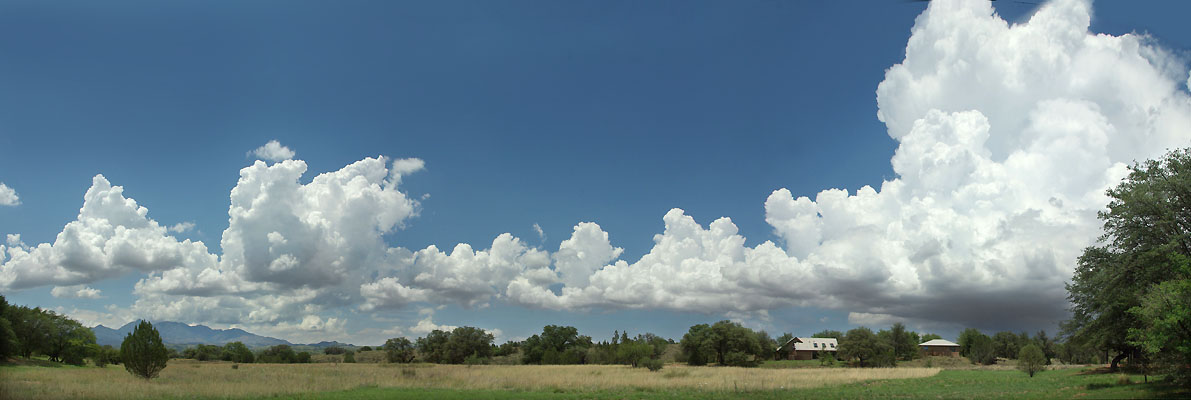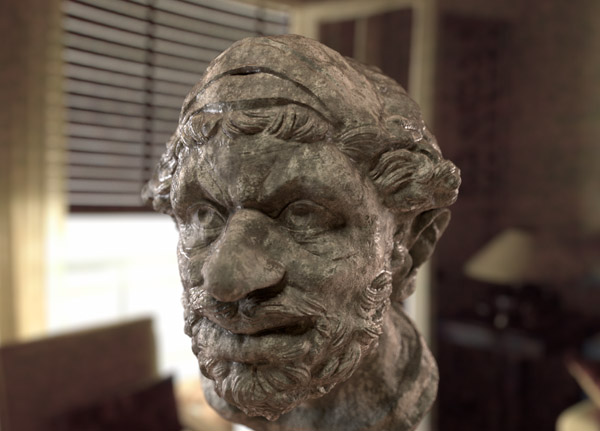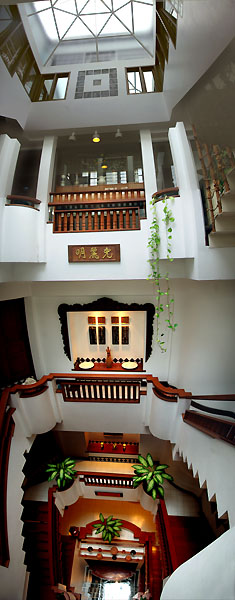Swiss Panoramic Images + Urban Lines
-
An easy and accurate way to find a nodal point:
1 Put your camera on a tripod
2 Take two light stands and line them up in the middle of your frame with one behind the other.
3 Rotate your camera left and right until the light stands touch the edge of the frame.
4 If the light stands remain aligned, one behind the other, you have found the nodal point.
5 If one light stands pops out from behind the other you must move the camera back and forth relative to the rotation axis of the tripod until the light stands remain aligned.
6 To move the camera relative to the rotational axis of the tripod you need a pano head that lets you slide the camera back and forth while you search for the nodal point. You need to mark this sliding stage to show the nodal point of each of your prime lenses. (a prime lenses is a lens with only one focal length i.e. a non zoom lens.)
7 With telephoto lenses imaging subjects at a distance the correct nodal point will have little significance to your final image. With wide angle lenses imaging prominent foregrounds, you have to place the nodal point accurately or the images will not stitch.Hope this helps and am glad to answer any questions.
-
Hi Roger and thank you for your help. This is the technical information I need, I still have lots to learn.
I am looking to buy the nodal ninja tripod below: Which of the two would be most practical for my needs?

I am looking at either NN4:

Or the Ultimate M1:
Also this camera:
And this lens:
-
A fish eye lenses.
Meanwhile, an equirectangular panorama is a 1x2 image. Your wonderful panoramas miss the upper and down information.
I still don't understand the geometry of this 'equirectangular' thing.
-
@michaliszissiou said:
Meanwhile, an equirectangular panorama is a 1x2 image. Your wonderful panoramas miss the upper and down information.
I still don't understand the geometry of this 'equirectangular' thing.Yeah exactly, by orientating the camera portrait you achieve this up and down information....also you take a photo directly upwards and one directly downwards to complete the equirectangular image.
So you take 6 photos around, one up and one down. 8 wide-angle photos in total.
-
Read this page below Michalis:

Rosauro Photography - Stitching Process 1, Intro To Panoramas, VR Head Reviews
rosaurophotography.com : Photographs, panoramic images, VR Head Reviews
(www.rosaurophotography.com)
Imagine the applications though, say you are designing a building for a new site.....No need to model the site for prelims, you can just take a spherical image for visualization rendering.
-
@olishea said:
Hi Roger and thank you for your help. This is the technical information I need, I still have lots to learn.
I am looking to buy the nodal ninja tripod below: Which of the two would be most practical for my needs?

I am looking at either NN4:

Or the Ultimate M1:
Also this camera:
And this lens:
Oliver, a great question. A simple question but hard to answer because it branches out in many directions. But I will try.
We need to analyze your goals. Do you want to use a DLSR to make prints with more resolution than an 11x14 camera? Or do you want to take fish eye photos that serve as virtual environments for renderings? Are you going to be shooting in bright sun or at night under available starlight? Do you want to travel light or are prepared to lug around whatever it takes? Will you be placing a single story building in a broad landscape shot from a distance or will you be shooting the Sears Tower from across the street? For most uses you don't need any sophisticated equipment and for extreme cases you do. If lenses were perfect and if film/sensors had infinite resolution all cameras would come with just one fisheye lens an you just crop into the image to get the composition you want. Wide angle distortion DOES NOT exist. Wide angle perspective does exist and we call it distortion. The eye only takes sharp pictures across perhaps 10 degrees of vision. If I stare at this screen without moving my head or eyeballs, I can only see the words "perhaps 10" sharply. However that is not my normal visual perception because my eyes constantly scan the area in front of me and "stitch together" a perception. And that is not all that happens. We live with a lot of rectilinear shapes so we know about straight lines and right angles. Because we "know about these things" the mind takes the curves we actually see and straightens the edges. So if you want to make a print 9ft long and 1ft high for your bed room wall with a very wide perspective, you cant get by with the fisheye as the picture would look soft and blurry at that magnification. To get around that limitation you can stitch together 10 or 12 photos with a normal lens and have a file of 100 to 200 megapixels that will be sharp as a tack at 9ft x 1ft. Now if you want to use a fisheye you can have a 5 megapixel or lower file if you want to use the scene as a light source and a rendering background. You can get away with this because any low res blur will be perceived as depth of field effect. So you only need stitched photos to increase the resolution limit of your camera or to get a wider angle shot than your lens would normally allow. If you are creating a 9ft x 1ft photo, nodal point probably won't be an issue because you won't have much foreground or foresky because the format is too narrow for either one to show. So one row panos rarely have a problem with photo alignment when you do the stitching. But lets say you want to stitch super high res photo that will print sharply at 9x12 feet. Now, instead of one row of photos, you will need a lot more photos arrayed in multiple rows. Because of the more rectangular photo you will have much more foreground and sky and the tile floor just in front of you will be much closer than buildings on the horizon. In this case if the nodal point is off the tile floor will simply not stitch together. It is here that you must have something to stabilize your nodal point. The more stuff on the groundplane in the foreground the more you need to control the nodal point. Cell phones are forgiving because they are only a couple mm thick and it is hard to get too far from the nodal point. With a big telephoto, the nodal point can get way off from where you are rotating the camera, maybe more than a foot. This can become unstitchable. For a one row pano of fairly flat land I can go fairly freehand with most lenses. If I want super resolution wide angle image consisting of many telephoto shots I can use the method described in the previous post to determine my lenses nodal point. I have to keep the nodal point fixed relative to a fixed point on the ground. How can I do that? One way is to buy an expensive nodal ninja at $300 to $400. Another way is throw a coin on the ground to mark my fixed point that I will rotate the camera about. Then I can put a loop of string around my long lens at the position of the nodal point and hang a plumb bob (a 20 cent washer) on a string that almost reaches the coin on the ground. Now with no tripod and under 20 cents of equipment I can do a really detailed one row pano and spend the $400 on a really nice lunch. Let me diverge for a moment to introduce another complication - time. The worst Pano I ever saw was was taken on a really windy day and the same cloud kept reappearing again and again and again ad infinitum all across the pano. The problem was not nodal point but the cloud was moving across the scene at the same rate the photographer was panning and reframing the shots that would make up the pano. So here, the ultimate tool is anything that thing reduces the speed at which you can take your shots and keep the nodal point consistent. Gigapan systems make robotic tripod heads. With this you point the camera to the bottom left of your final scene and punch a button to record the position then you do this again to mark the position for the upper right exposure. Next you figure out the time for your camera to record the scene and write the info to the data card. You key the resulting interval between exposures into the camera. You also key in the desired overlap between frames (30% is a good rule of thumb. When you finally press the go button the robot takes you input and precalculates the precise position of every shot before machine gunning through the entire picture array as fast as you input data will let it go. This tool will set you back $800 to $1200 dollars. Photos of Obama's inauguration showed 10,000 people on the capitol mall and you can still zoom in with enough resolution to see Joe Biden's cuff links. Now for general daylight lighting simulation lighting and rendering backgrounds, I would go with the string and the washer. If you are going to make giant display prints in hostile environments for high res interactive virtual environments or games, you might want the gigapan. For me, if I was doing really high end display prints of architectural interiors for picky clients paying big bucks for the result, one of the nodal Ninja devices might be just the ticket. I will look at the two units a little more and get back to you.
-
The ultimate M1 will let you go to a 200 MM lens. With Pano photography this really translates to more resolution and the rotator can be et to fixed intervals without actually reading the scale. Your other choice says the longest lens to be used is a 100 mm and the rotator has not fixed detents so you will have to read and lock the device for each camera move. Consider my last post and if you really need, want and can afford the device go for the M1. For most situations you can get away with 40 cents of string and washers. If you are going to do repeated high end work and lugging fragile and expensive equipment then go nodal ninja or a robotic system.
-
I think I need another coffee to read all that again!!

-

OLI, let me translate it for you.
Buy the cheapest camera with a fisheye lenses.
But it has to be capable to work manually.
And learn how to stitch equirectangular panoramas. I did some progress on this (hugin).
But I have a d300 Nikon and a 17mm only wide lenses. (and some expensive lenses like 50mm 1.4, or some nice expensive zoom lenses)
A 17mm means equivalent to ~25mm under dSLR format. Not much for such panoramas.
Is there any cheap adaptor-lenses for use on ipad?
Indeed, only pain came from using my dSLR for such a purpose.About equirectangular panoramas. I did some search and the only I can understand is that: basically there are two 180º wide square photos, stitched together. A 1x2 format.
Am I right? -
@unknownuser said:
No, There are 6 photos taken every 60 degrees, then one photo up, and one to two photos down (nadir)
Yeah right, these are technics though. But the finished work shows always two 180º perfect shots, perfectly stitched. Theoretically speaking.

Oli they can be as many photos as you like. Any lenses can work. You have two perfectly round shots in the end that you'll try to stitch. Theoretically speaking...
-
I know, my urban panoramas were up to 20 photos wide!!
 lots of stitching.
lots of stitching.You can see any better techniques?
-
 By the way for anyone who is interested Microsoft ICE (Image Composite Editor) is robust, free and easy to use. This is a handheld pano done without a tripod.
By the way for anyone who is interested Microsoft ICE (Image Composite Editor) is robust, free and easy to use. This is a handheld pano done without a tripod. -

This is also a handheld 180 degree pano composed of 18 vertical frames and shot with a 300mm lens. At full resolution you can almost read the license plates on cars. This is the town of Galera (in the heart of Andalucia), Spain which is famous for its cave houses. As I hobbled around the town we passed a street called Calle Quijote just as an old lady threw a bucket of wash water into the street. I asked, "?Donde esta el ingenioso hidalgo?" I got a blank stare and assumed she was not much for literary references. -
Very nice panoramas, but I need equirectangular 1x2 panoramas. The worse is I need interiors. The worst is that I need hdris and mostly empty places.
I need them badly. Good luck to me. -
Thought you might find this interesting.
It is a post over on the Thea site.http://www.thearender.com/forum/viewtopic.php?p=73432#p73432
It leads to this website, where you can compose panos online it appears.
http://www.360cities.net/ -
Anyway, I tried with ipad. Lot of noise but some success.
A pure blender sculpt in my home, with some help of additional lighting (I admit it). But environment requirectangular panoramic worked. (some stretching still there, and lot of noise
-
@michaliszissiou said:
Anyway, I tried with ipad. Lot of noise but some success.
A pure blender sculpt in my home, with some help of additional lighting (I admit it). But environment requirectangular panoramic worked. (some stretching still there, and lot of noise[attachment=0:25yr8u6a]<!-- ia0 -->testingequirect.jpg<!-- ia0 -->[/attachment:25yr8u6a]
So, you are aware of Paul Debevic's work with light probes? I see from your sculpt that you want your pano to serve as both light source and background image. I think I would use the pano as light source and do a small HRI image Photoshopped behind the head. In regard to my panos, had I continued shooting around the nodal point in all directions, the result would have been an equirectangular 1x2 after it had been stitched. You can set up your camera and a gigapan system to do HDRIs and the pano at the same time. The robot will bracket exposures at each camera position befor advancing to the next position.
-

A vertical pano/HDRI showing seven floors of a Thai shop house.
-
@roger said:
You can set up your camera and a gigapan system to do HDRIs and the pano at the same time
This is what I am aiming to achieve.
You see in my urban panoramas, some of them are completely 360 degrees but I couldn't post-stitch them into an equirectangular format. They can still serve perfectly for backgrounds but they do not render accurately. Of course you can replace the background but that's not the point.
@unknownuser said:
Very nice panoramas, but I need equirectangular 1x2 panoramas. The worse is I need interiors. The worst is that I need hdris and mostly empty places.
I need them badly. Good luck to me.Well give me a week or two! I'm going shopping this weekend!

-
Roger I will PM you an in-depth reply. Thank you for your wisdom.
@michaliszissiou said:
About equirectangular panoramas. I did some search and the only I can understand is that: basically there are two 180º wide square photos, stitched together. A 1x2 format.
Am I right?No, There are 6 photos taken every 60 degrees, then one photo up, and one to two photos down (nadir).
Look at the first few images of this tutorial, it shows how tripod is set up with resultant images.
You need 8-9 portrait wide angle photos.
 http://www.rosaurophotography.com/html/technical3.html
http://www.rosaurophotography.com/html/technical3.html@michaliszissiou said:
Buy the cheapest camera with a fisheye lenses.
But it has to be capable to work manually.I need a good quality dslr as I will be using it for other applications too, not just panos. Looking at nikon d5100 or d90, can't decide. The D90 seems to be a more professional oriented camera, I don't care much for better video quality on the d5100. d5100 does not have auto focus built-in either.
It's either this
or this
Advertisement







